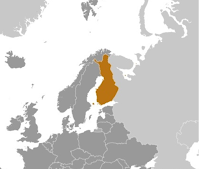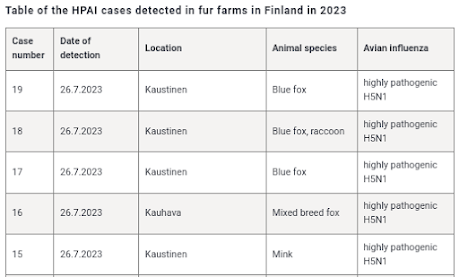Finland - Influenza A viruses of high pathogenicity (Inf. with) (non-poultry including wild birds) (2017-) - Immediate notification
GENERAL INFORMATION
COUNTRY/TERRITORY OR ZONE
ZONE
ANIMAL TYPE
TERRESTRIAL
DISEASE CATEGORY
Listed disease
EVENT ID
5119
DISEASE
Influenza A viruses of high pathogenicity (Inf. with) (non-poultry including wild birds) (2017-)
CAUSAL AGENT
Highly pathogenic avian influenza virus
GENOTYPE / SEROTYPE / SUBTYPE
H5N1
START DATE
2023/07/06
REASON FOR NOTIFICATION
Unusual host species
DATE OF LAST OCCURRENCE
-
CONFIRMATION DATE
2023/07/13
EVENT STATUS
On-going
END DATE
-
SELF-DECLARATION
NO
REPORT INFORMATION
REPORT NUMBER
Immediate notification
REPORT ID
IN_161810
REPORT REFERENCE
-
REPORT DATE
2023/07/13
REPORT STATUS
Validated
NO EVOLUTION REPORT
-
EPIDEMIOLOGY
SOURCE OF EVENT OR ORIGIN OF INFECTION
Unknown or inconclusive
EPIDEMIOLOGICAL COMMENTS
A focal outbreak on a fur farm raising arctic foxes and raccoon dogs. Plenty of black-headed gulls have been observed around and at the fur farm. Currently no control measures are applied as HPAI is not "listed disease" in fur animals. Further sampling is planned on the fur farm. Veterinary authorities are working in tight collaboration with the public health authority. Improved biosecurity measures and use of personal protection equipment on fur farms are encouraged.
...
NEW OUTBREAKS
OB_121770 - KAUSTINEN
OUTBREAK REFERENCE
-
START DATE
2023/07/06
END DATE
-
DETAILED CHARACTERISATION
-
FIRST ADMINISTRATIVE DIVISION
Länsi- ja Sisä-Suomen aluehallintovirasto
SECOND ADMINISTRATIVE DIVISION
Keski-Pohjanmaa
THIRD ADMINISTRATIVE DIVISION
Kaustinen
EPIDEMIOLOGICAL UNIT
Farm
LOCATION
Kaustinen
Latitude, Longitude
63.549 , 23.692
(Approximate location)
OUTBREAKS IN CLUSTER
-
MEASURING UNIT
Animal
AFFECTED POPULATION DESCRIPTION
A focal outbreak in a fur farm. Increased mortality in litters, also some adult animals have died. Three pups were examined and found positive for HPAI H5N1.
SpeciesSusceptibleCasesDeathsKilled and Disposed ofSlaughtered/ Killed for commercial useVaccinated
Raccoon dog (WILD)
Captive
NEW 1500 - - - - -
TOTAL 1500 - - - - -
Arctic Fox (WILD)
Captive
NEW 3500 3 3 - - -
TOTAL 3500 3 3 - - -
All species
NEW 5000 3 3 - - -
TOTAL 5000 3 3 - - -
...
GENERAL INFORMATION
COUNTRY/TERRITORY OR ZONE
ZONE
ANIMAL TYPE
TERRESTRIAL
DISEASE CATEGORY
Listed disease
EVENT ID
5119
DISEASE
Influenza A viruses of high pathogenicity (Inf. with) (non-poultry including wild birds) (2017-)
CAUSAL AGENT
Highly pathogenic avian influenza virus
GENOTYPE / SEROTYPE / SUBTYPE
H5N1
START DATE
2023/07/06
REASON FOR NOTIFICATION
Unusual host species
DATE OF LAST OCCURRENCE
-
CONFIRMATION DATE
2023/07/13
EVENT STATUS
On-going
END DATE
-
SELF-DECLARATION
NO
REPORT INFORMATION
REPORT NUMBER
Immediate notification
REPORT ID
IN_161810
REPORT REFERENCE
-
REPORT DATE
2023/07/13
REPORT STATUS
Validated
NO EVOLUTION REPORT
-
EPIDEMIOLOGY
SOURCE OF EVENT OR ORIGIN OF INFECTION
Unknown or inconclusive
EPIDEMIOLOGICAL COMMENTS
A focal outbreak on a fur farm raising arctic foxes and raccoon dogs. Plenty of black-headed gulls have been observed around and at the fur farm. Currently no control measures are applied as HPAI is not "listed disease" in fur animals. Further sampling is planned on the fur farm. Veterinary authorities are working in tight collaboration with the public health authority. Improved biosecurity measures and use of personal protection equipment on fur farms are encouraged.
...
NEW OUTBREAKS
OB_121770 - KAUSTINEN
OUTBREAK REFERENCE
-
START DATE
2023/07/06
END DATE
-
DETAILED CHARACTERISATION
-
FIRST ADMINISTRATIVE DIVISION
Länsi- ja Sisä-Suomen aluehallintovirasto
SECOND ADMINISTRATIVE DIVISION
Keski-Pohjanmaa
THIRD ADMINISTRATIVE DIVISION
Kaustinen
EPIDEMIOLOGICAL UNIT
Farm
LOCATION
Kaustinen
Latitude, Longitude
63.549 , 23.692
(Approximate location)
OUTBREAKS IN CLUSTER
-
MEASURING UNIT
Animal
AFFECTED POPULATION DESCRIPTION
A focal outbreak in a fur farm. Increased mortality in litters, also some adult animals have died. Three pups were examined and found positive for HPAI H5N1.
SpeciesSusceptibleCasesDeathsKilled and Disposed ofSlaughtered/ Killed for commercial useVaccinated
Raccoon dog (WILD)
Captive
NEW 1500 - - - - -
TOTAL 1500 - - - - -
Arctic Fox (WILD)
Captive
NEW 3500 3 3 - - -
TOTAL 3500 3 3 - - -
All species
NEW 5000 3 3 - - -
TOTAL 5000 3 3 - - -
...















Comment